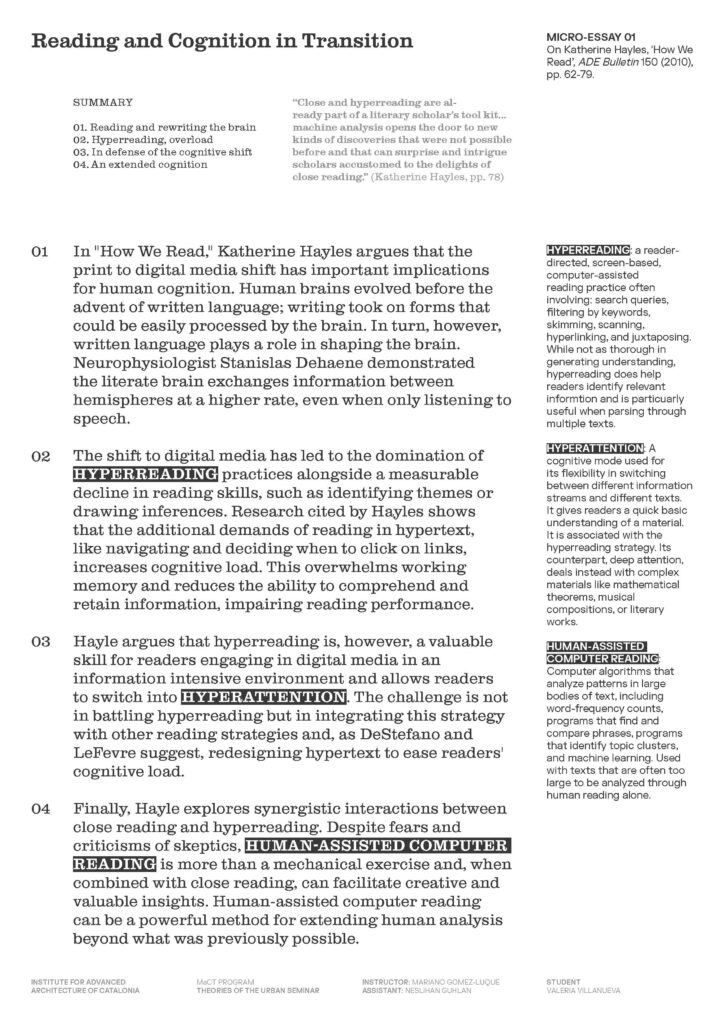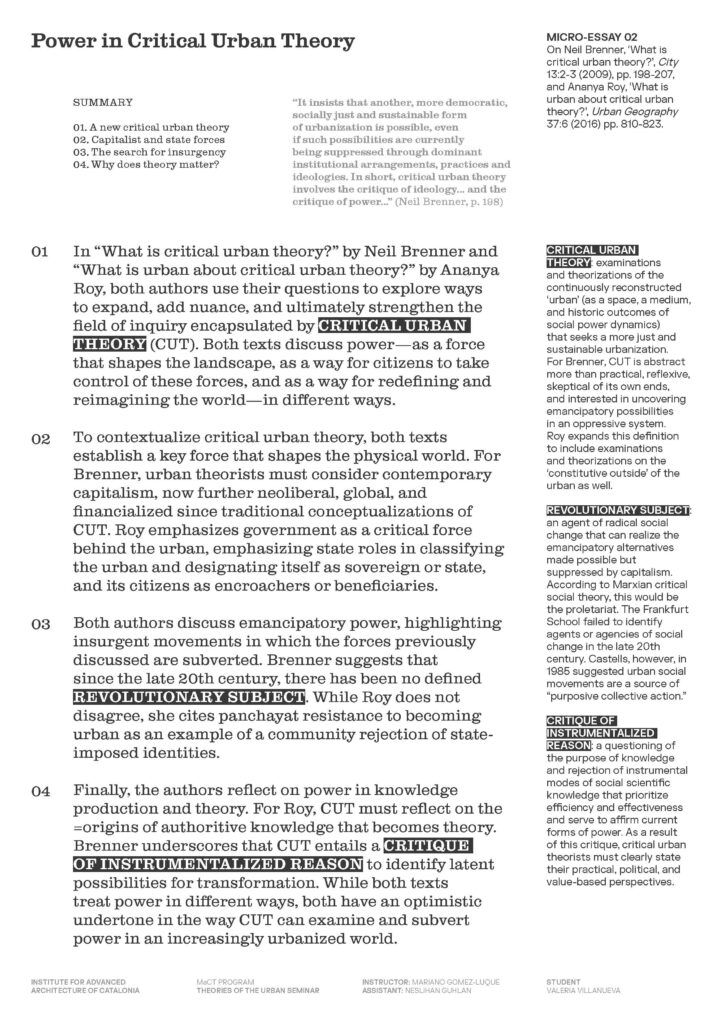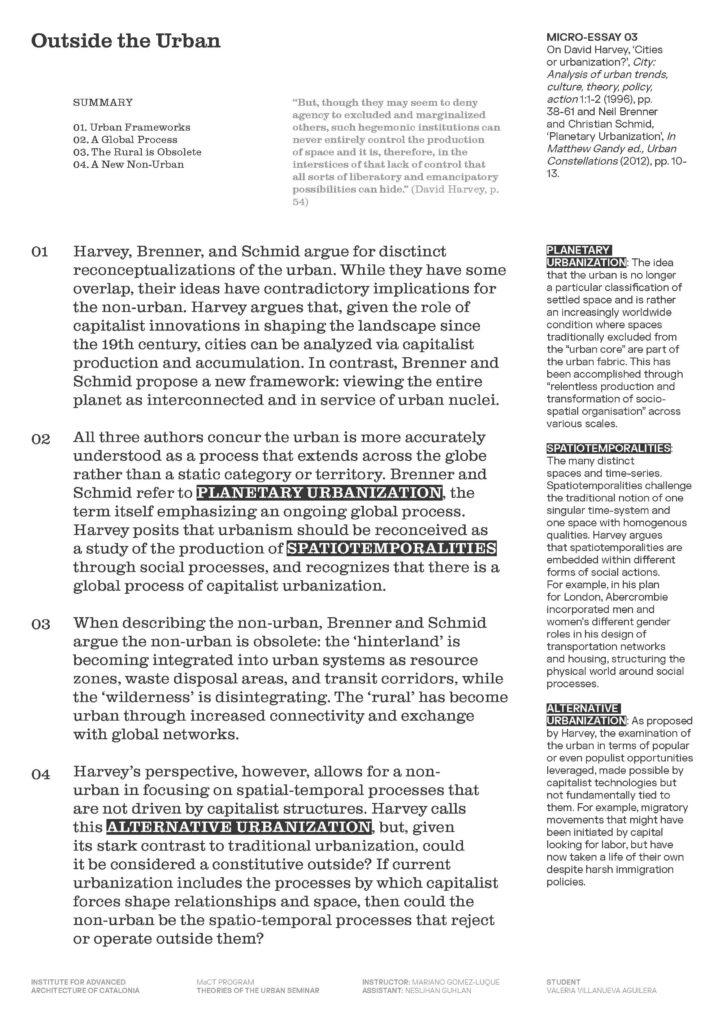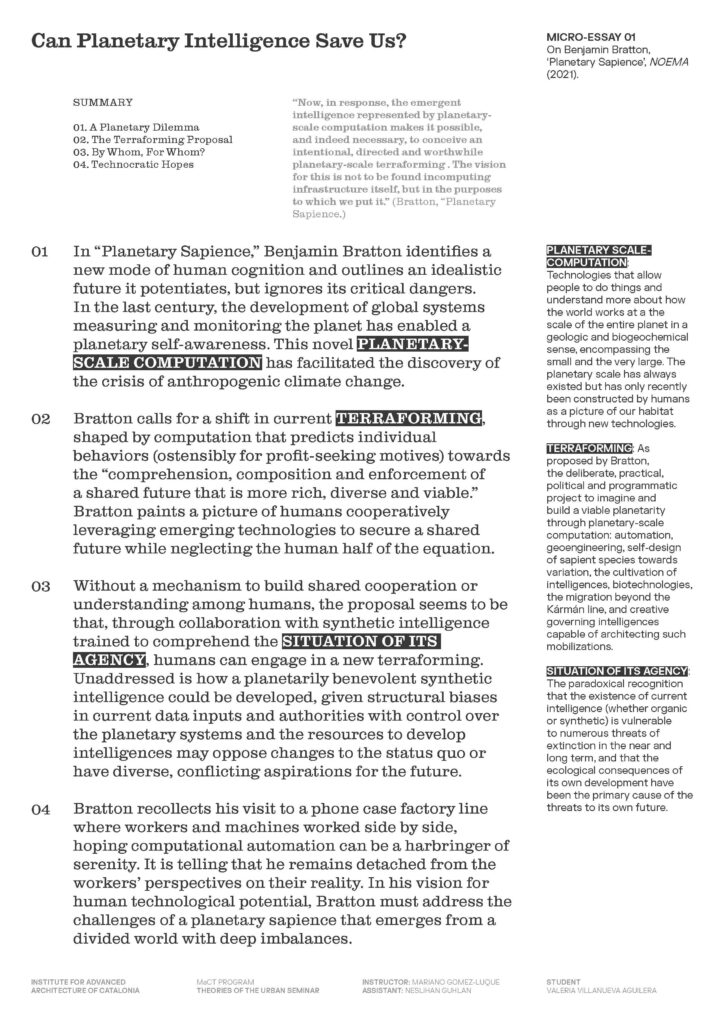SUMMARY
01. An Adapted Urbanism
02. Extended Cognitions
03. Excavating Futures
04. In Defense of the Local
“The places whose stories I am trying to tell cannot be understood as geographies
of urbanization. Nor can the politics of space present in these locations be read
as urban in the ways in which critical urban theory would lead us to believe.”
(Ananya Roy, p. 819)
01.
The year is 2024, and for the past two centuries, capitalism has shaped technological innovation, bringing forth radical shifts in the way space is organized as well as the logics in which humans operate. Critical geographer David Harvey argues as much in his
2007 essay “Cities or Urbanization,” citing the revolution in telecommunications as one of the latest developments at the time. With the rise of the internet and artificial intelligence in recent years, urbanism must adapt to understand and excavate the new modalities brought forth by these technologies.
02.
The new tools mark not only a spatial shift, but a cognitive one as well. Media and literary scholar Katherine Hayles writes that the multilocal context of contemporary media triggers a mental shift into hyper attention and cognitive overload, but this instinct can be leveraged and adapted to synergistically combine practices like close-reading and hyper-reading into HUMAN-ASSISTED COMPUTER READING.
Simultaneously, these new technologies have become a “smart exoskeleton,” an accidental megastructure that facilitates PLANETARY-SCALE COMPUTATION. This, according to philosopher of technology Benjamin Bratton, allows humans to use SYNTHETIC INTELLIGENCE to TERRAFORM in new, intentional ways.
03.
The same technologies that allow humans and the world to become computational have borne a new kind of urbanization, a neoliberalization of the design of spaces and the material inputs required. Harvey notes that new technologies have broken down spatio-temporal barriers and created a metabolic rift between the city and its metabolic landscape while corporations abandon cities to the devices of speculators and financial capital.
Niel Brenner, an urban theorist known for PLANETARY URBANIZATION, believes that, like critical theory, CRITICAL URBAN THEORY must explore new conditions of possibilities within oppressive systems. Should urbanists transition to a planetary perspective and embrace Bratton’s proposal to attain viable planetarity from collaboration within synthetic intelligence?
04.
The work of Ananya Roy, an urban theorist who focuses on postcolonial development, reminds the field of the nuance that is lost, particularly in the Global South, when taking a solely top-down, or global-to-local approach. Roy challenges Brenner, suggesting
that the constitutive outside of the urban is worthy of attention. She further argues that urbanists must reflect on the origins of authoritive knowledge that becomes theory, with important implications for the knowledge that would inform synthetic intelligence. If, like Harvey posits, urbanization is produced socially through SPATIOTEMPORALITIES, urbanists have a responsibility to examine these social dynamics at their various scales. Beyond leveraging planetary computational tools for a better future, the field must also engage with the realities of people and places that are overlooked by the technologies of today.
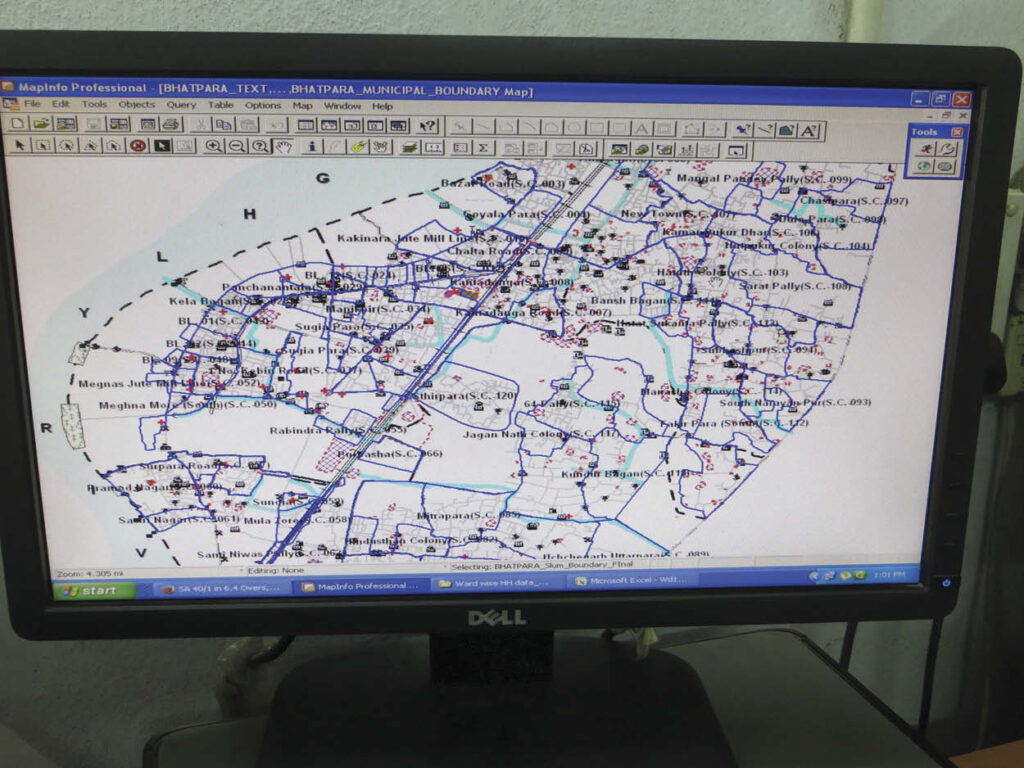
KEYWORDS
HUMAN-ASSISTED COMPUTER READING: Computer algorithms that analyze patterns in large bodies of text, including programs that find and compare phrases, programs that identify topic clusters, and machine learning. Used with texts that are often too large to be analyzed through human reading alone and across monolocal and multilocal contexts (rich, single text and juxtaposed texts).
PLANETARY-SCALE COMPUTATION: Technologies that allow people to implement projects and better understand how the world works at the scale of the entire planet in a geologic and biogeochemical sense, encompassing the small and the very large. The planetary scale has always existed but has only recently been constructed by humans as a picture of our habitat through new technologies.
SYNTHETIC INTELLIGENCE: A form of intelligence that is truly smart, opposed to artificial intelligence which is merely designed to appear like human intelligence. Synthetic intelligence implies the synergy of human and machine intelligence towards insights or creativity that would be impossible otherwise.
TERRAFORM: The deliberate, practical, political and programmatic project to imagine and build a viable planetarity through planetary-scale computation: automation, geoengineering, self-design of sapient species towards variation, the cultivation of intelligences, biotechnologies, the migration beyond the Kármán line, and creative governing intelligences capable of architecting such mobilizations.
PLANETARY URBANIZATION: The idea that the urban is no longer a particular classification of settled space and is rather an increasingly worldwide condition where spaces traditionally excluded from the “urban core” are part of the urban fabric. This has been accomplished through “relentless production and transformation of sociospatial organisation” across various scales.
CRITICAL URBAN THEORY: examinations and theorizations of the continuously reconstructed ‘urban’ (as a space, a medium, and historic outcomes of social power dynamics) that seeks a more just and sustainable urbanization. For Brenner, critical urban theory is abstract more than practical, reflexive, skeptical of its own ends, and interested in uncovering emancipatory possibilities in an oppressive system.
SPATIOTEMPORALITIES: The many distinct spaces and time-series. Spatiotemporalities challenge the traditional notion of one
singular time-system and one space with homogenous qualities. Harvey argues that spatiotemporalities are embedded within different forms of social actions.
TEXTS
Benjamin Bratton, ‘Planetary Sapience’, NOEMA (2021).
Neil Brenner, ‘What is critical urban theory?’, City 13:2-3 (2009), pp. 198-207.
Neil Brenner and Christian Schmid, ‘Planetary Urbanization’, In Matthew Gandy ed., Urban Constellations (2012), pp. 10-13.
David Harvey, ‘Cities or urbanization?’, City: Analysis of urban trends, culture, theory, policy, action 1:1-2 (1996), pp. 38-61.
Katherine Hayles, ‘How We Read’, ADE Bulletin 150 (2010), pp. 62-79.
Ananya Roy, ‘What is urban about critical urban theory?’, Urban Geography 37:6 (2016) pp. 810-823.
